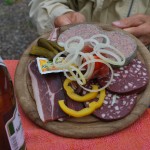Stereotypes drive me crazy. It’s so easy to say that Americans eat burgers and steaks and Germans eat sauerkraut and brats. So when my friends elected me to be their travel guide for a two-week trip to Germany, I was glad to finally put this myth to rest at least with them. Don’t get me wrong, I like sauerkraut and I even cook it once in a while. But not the way we eat it in the U.S., right out of the can to pucker your mouth from a foot away.
Black Forest
Our first stop took us to the Black Forest, its wealth of wild game represented in its dishes. You’ll find all types of venison concoctions, ragouts and roasts of wild boar, deer and Hirsch,

the male deer, also rabbit, hare and wild trout. Accompany that with Spaetzle, a thick oddly shaped noodle, ideally suited to sop up gravies, and variations of potatoes, like Kroketten, mashed potatoes shaped into roles and deep-fried, and you’ll have an assortment of mouthwatering dishes, topped only by the real Black Forest torte.

Wait a minute, you say. I have eaten Black Forest cake from the local grocer. Not really. The original black forest torte cannot be compared with anything being baked or should I say faked in the U.S. The cake is made with Black Forest cherries, a small variety of sour cherries only grown in the region and Kirschwasser, a clear, high octane, unsweetened schnapps, distilled from the same cherries. Add to that chocolate cake, covered with chocolate, mountains of whipped cream and more chocolate sprinkles and you get a Black Forest paradise, even a full stomach can’t resist.
Mosel Region
Deeply set between steep hills, the Mosel meanders in snaking loops toward the Rhine. Two-thousand years ago, the Romans settled here to enjoy hot springs and teach locals how to grow wine. Hundreds of family businesses still compete with a few large producers to grow Riesling, Mueller-Thurgau and the occasional pinot, each with their own interpretation, designs and crazy names like Kroever Nacktarsch or Bernkasteler Doktor. No meal is complete without trying the house wine. On the menu, a cornucopia of pastas with meat, rump steak with green pepper sauce, more venison dishes, potato cakes and vegetables. No sauerkraut. Not one dish. Not even cooked cabbage.

Instead we found separate asparagus menus, German restaurants offer during May and June. Compared to our green asparagus, the European variety is white and much thicker. Peeled and steamed in salt water, it tastes milder than its American cousin and is typically offered with boiled potatoes, accompanied by smoked or cooked ham, schnitzel yes, I was going to mention them and of course, the queen of sauces, hollandaise.
Mid-Rhine Region
The majority of German towns offer regional or citywide specialties, and the Mid-Rhine Region, including Cologne, Duesseldorf, Solingen and Krefeld is no exception. In Cologne you can order a Halve Hahn which translated means half a rooster, except that it has nothing to do with meat. Can you guess? It’s a bread roll with Gouda cheese. Another staple on most menus is the lowly herring. While we may be familiar with the sour herring, the virgin

herring, called Matjes, tastes mild and melts in your mouth. It is served plain with onion rings, mixed with cream or chopped with apples in herring salad and accompanied by potatoes. We still didn’t find sauerkraut.
Lake Constance
Traveling around Lake Constance, or the Bodensee, in the southwestern corner of Germany, we came across the famous Bodensee Felchen, a lake trout, fried in butter and lemon, smoked or boiled blue. Like most places in Germany, we found Schnitzel variations, either made with traditional pork tenderloin or veal, breaded and fried, combined with toppings, including plain with a wedge of lemon, hunter-style with mushroom sauce, Hungarian with red or green peppers or baked with spinach and cheese. Or topped with a fried egg as a snack for in-between. Thanks to Germany’s Italian neighbors, we enjoyed baked tortellini with chicken in cream sauce, spaghetti with vegetable and cheese toppings.

But of course, Germans must eat sauerkraut. Somewhere. That’s correct, I have to admit. Though we didn’t visit all sixteen German states, I know, sauerkraut is prevalent in Bavaria. Most other places rarely consider it a restaurant-worthy dish.
My American friends were convinced. But they still want to eat my sauerkraut.
